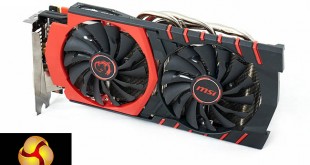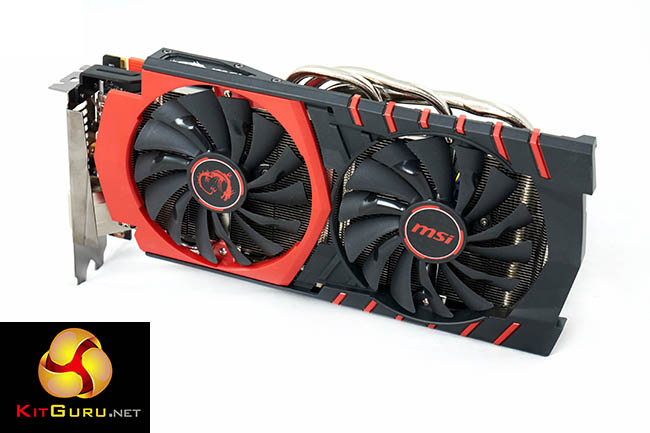
Today we take a look at the MSI GTX960 Gaming 2G OC Edition – another custom Nvidia partner card featuring the popular and somewhat attractive red MSI cooling solution. This card receives a core clock boost and substantial heatsink design to help drop temperatures. How does it compare with the other GTX960 cards we have reviewed so far?

The MSI cooling solution has proven popular with our readers – red and black certainly has been the ‘go-to' colour scheme for many companies in the last year. This MSI OC model is said to ship with aggressive clock speeds so lets take a look…
How does the technology behind the GTX960 stack up?
| GPU | GeForce GTX 750ti (Maxwell) | GeForce GTX 960 (Maxwell) | Geforce GTX 970 (Maxwell) | GeForce GTX 980 (Maxwell) |
| Streaming Multiprocessors | 5 | 8 | 13 | 16 |
| CUDA Cores | 640 | 1024 | 1664 | 2048 |
| Base Clock | 1020 mhz | 1126 mhz | 1050 mhz | 1126 mhz |
| GPU Boost Clock | 1085 mhz | 1178 mhz | 1178 mhz | 1216 mhz |
| Total Video memory | 2GB | 2GB | 4GB | 4GB |
| Texel fill-rate | 40.8 Gigatexels/Sec | 72.1 Gigatexels/Sec | 109.2 Gigatexels/Sec | 144.1 Gigatexels/Sec |
| Memory Clock | 5400 mhz | 7010 mhz | 7000 mhz | 7000 mhz |
| Memory Bandwidth | 86.4 GB/sec | 112.16 GB/sec | 224 GB/s | 224 GB/sec |
| Bus Width | 128bit | 128bit | 256bit | 256bit |
| ROPs | 16 | 32 | 64 | 64 |
| Manufacturing Process | 28nm | 28nm | 28nm | 28nm |
| TDP | 60 watts | 120 watts | 145 watts | 165 watts |
Nvidia’s GTX960 GM206 ships with 1,024 CUDA cores – significantly more than the 640 CUDA cores available on the GTX750ti, but half the amount featured on the flagship GTX980 (2,048).
A bone of contention within the enthusiast audience will be the somewhat limited 128 bit memory interface – identical to the GTX750ti. Nvidia are keen to point out however that the Maxwell memory architecture is approximately 33% more efficient than Kepler. We do delve into this a little deeper on the architecture page later in the review.
Nvidia's reference clock speeds are set at 1,126mhz (1,178mhz boost), with 32 ROPs and 64 texture units. MSI have three different clock configurations for this card, two of which are only available via proprietary MSI software. I have to admit I am not impressed with how this has been handled, but I will delve into it in more detail on the ‘Architecture and Overclocking' page of the review today.
 KitGuru KitGuru.net – Tech News | Hardware News | Hardware Reviews | IOS | Mobile | Gaming | Graphics Cards
KitGuru KitGuru.net – Tech News | Hardware News | Hardware Reviews | IOS | Mobile | Gaming | Graphics Cards



Fully agree. It’s the reason I won’t buy another MSI “Gaming” card. I have to use the Gaming App or Afterburner to OC my GTX 760 Gaming card to get the clock speeds MSI advertise. This is silly. I want to install a card and forget it. I need an upgrade for my kids’ HTPC/Gaming rig but don’t want to have to select the OC every time we turn it on. You were right to test this card at the out of box clocks. MSI need to learn from this. Asus card for me next, once the GTX 960 Ti comes out! That’ll be a worthy upgrade to our GTX 650 Ti.